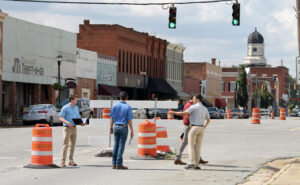 University of Georgia College of Engineering students put their academic coursework into action this year by serving rural Georgia communities, completing capstone design projects in five UGA Archway Partnership counties.
University of Georgia College of Engineering students put their academic coursework into action this year by serving rural Georgia communities, completing capstone design projects in five UGA Archway Partnership counties.
The students worked alongside industry and community partners in Grady, Hart, Pulaski, Spalding and Washington counties. Projects ranged from assisting the implementation of a wastewater sludge management program in Spalding County to the structural assessment of a historic building in Grady County.
“Since 2014, the Archway Partnership and the College of Engineering has partnered on over 40 design projects,” said Stephan Durham, associate professor and dean for student success and outreach in the College of Engineering. “The college’s partnership with Archway is a mutually beneficial collaboration that works to provide soon to be engineering graduates with real-world design projects and client interactions while providing engineered designs and cost estimates for community improvement projects.”
Students work on the projects throughout the year and showcase them in April, competing for awards in six different categories. Ninety projects were featured in the showcase.
A remediation analysis of a brownfield site in Pulaski County won an award for Community Impact. That student team had to analyze hazard conditions, including contaminated soil and groundwater, at the NeSmith Gas Station. The county is considering donating the site to the city of Hawkinsville.
The students recommended measures to improve the site and developed a plan for a welcome sign, benches, a garden and other elements. A delegation of city councilmembers, the city manager and the county commissioner in Pulaski attended the showcase and were as impressed as the judges with the students’ work.
A wastewater discharge feasibility study in Hart County won for Sustainable Design. Hart County officials had feared that projected industry and population growth could increase demand for wastewater disposal beyond existing capacity. Students were commissioned to find feasible alternatives for future discharge. They identified an adjacent site where total discharge capacity could be increased to accommodate future industry.
“These civil and environmental capstone engineering projects are critical to the work being done in Archway Partnership communities,” said Angel Jackson, operations coordinator for the Archway Partnership. “The students’ work, ranging from trail design to wastewater management to site analysis, is phenomenal and we look forward to continuing this partnership in the years ahead.”
Leigh Anne Lloveras, an environmental engineering student, worked on a design for the Flint River Water Trail in Spalding County. Her team created designs for a place where boats could come in and out of the water along the Flint River. The project required close collaboration with the Flint River Water Trail Council and the City of Griffin and Spalding County Parks and Recreation Departments.
“Learning how to work with the community and see something tangible was the biggest takeaway for me,” Lloveras said. “We knew we could do the calculations but taking in public input and working with stakeholders was a big lesson.”
For more photos of the students’ engineering capstone work, click here.
By Baker Owens | Contact: Rob Gordon


